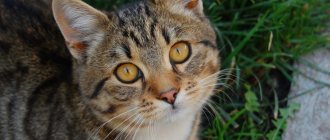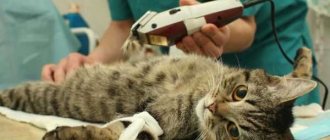Photo: TASS/Yuriy Smityuk
Cats are the most popular type of pet on the planet. We like them, we look at them on the Internet, tell stories about them and have them in our homes. But do we know everything about them? What secrets do our pets hide?
There are many superstitions about the mysterious abilities of cats. They are credited with nine lives, the ability to treat human diseases, and even connections with the other world. We decided to check the most common myths and understand what is true and what is mere fiction.
The incredible survivability of cats: a plane crash in 2011
I remember my grandmother telling me that cats are very tenacious creatures. They can fall from the fifth floor and not break. Of course, I didn’t try to conduct experiments, but I still heard more than once about this ability of moustaches. And just recently I came across this story.
On July 11, 2011, a fire was recorded on the AN-24 plane flight Tomsk - Surgut. The plane needed to be landed urgently, and the pilot made an emergency landing on the Ob River. Some of the victims were rescued. There was a cat on that flight that was not found as a result of the search.
Photo: TASS/Zurab Javakhadze
The wreckage of the plane began to be lifted from the water only eight days later. When it came to the cabin, the same lost cat named Chamomile jumped out. She ran away into the forest and came to people only a month and a half later.
In that plane crash, the cat Romashka risked dying more than once: she could have crashed against the bars of her cage during a hard landing, drowned in the water, or died of starvation in a flooded airliner or while wandering through the forest. But she managed to avoid all this. Maybe cats really have nine lives?
This is a real life story, and I will not judge whether it is an accident or not.
Causes of death of cats
There are several main causes of death for cats. First of all, these are age, illness and accidents, from which no one is insured. Like humans, a cat can die at the age of 10 years (40 in human years) from an accident.
From old age
There have been recorded cases of pets living up to 26 years or more, but this happens very rarely. After overcoming the 13-year mark, it is not difficult to find out that the cat will soon die. This is the pattern of all living things in nature.
With age, the animal becomes apathetic and does not play or frolic as before. The body's systems gradually fail, making themselves felt by pain, body lethargy and other characteristic signs.
From illness
Another possible reason for a cat leaving is illness. In veterinary medicine there is a whole list of diseases that most often affect the body of cats.
The leading place on the list is occupied by chronic failure of renal structures. The disease is especially typical for males who were untimely castrated. Disruption of metabolic processes associated with the restructuring of hormonal levels after castration (removal of the gonads in cats) leads to the onset of the formation of stones in the kidney structures.
Urolithiasis is quite difficult to treat, and often causes the death of a pet as a result of a violation of the functional features of the urinary system. Slow intoxication of the body occurs with half-life products of biological substances.
Naturally, in modern veterinary medicine, chronic kidney failure is not a death sentence, especially if the cat is still young, and the veterinarian is truly a professional who can take into account the individual characteristics of the animal’s body and select an adequate treatment regimen.
Note! With age and the onset of aging of the whole organism, chronic renal failure becomes more active and passes into the acute stage.
Experts recommend euthanasia so as not to torture the animal. The fact is that in case of chronic renal failure, when nothing else can be done except to slightly alleviate the symptoms and artificially prolong life, nothing else can be done.
The energetic power of cats
They say that cats have strong energy. Let's try to look at a pet from the point of view of extrasensory perception.
Photo: YAY/TASS
“A cat is an energetic substance, invisible to us, trembling, of a very high level, high frequency, that is, energy goes back and forth, it is not 220 volts in the current, digital representation. It's probably about a thousand volts. And this energy substance, thousands of volts, has eyes at the top that emit this energy in a living stream,” says psychic Arina Evdokimova.
The energy clot that a cat represents cannot be destroyed, the psychic believes. This is where those nine lives come from. Falling from a great height, finding itself in situations on the verge of life and death, the animal simply reincarnates. Of course, the human eye cannot see this.
The Institute of Ecology and Evolution studies the habits of all felines. Zoologist Anastasia Antonevich says the reason cats are so resilient lies in their behavior before they became domesticated. That is, the conditions of the wild in which they were for a long time were clearly reflected in the genetic code of the animal. This is why cats are so highly adapted to survival.
“In life they have adaptations to jump well, fall well, because they climb a lot, and also it has to do with how they hunt. Due to the fact that they hide, they have a very flexible gait, flexible movements, a very flexible body,” says senior researcher at the Institute of Economics and Economics named after. A. N. Severtsova RAS Anastasia Antonevich.
How to understand that a cat is dying - 8 signs
Learning how to recognize when your cat is dying can help ease the pain of losing a pet. It is known that animals sense the approach of someone else's and their own death. This phenomenon has not yet been solved. A cat instinctively senses the proximity of a catastrophe, earthquake, fire, death, or illness of the owner. Observations are based only on situations confirmed by people from life experience.
How to understand that a cat is dying - signs:
- Showing tenderness and calmness. Pets, even unsociable ones, will begin to fawn, ask to be held, purr loudly, lick their hands and face, and be caressed. Uncharacteristic calmness manifests itself in the gaze.
Decreased activity. Before they die, pets become very slow and stop jumping and running. To make the last few days easier, you should move the bowl with the drinking bowl to the bed.
Changes in appetite. Usually the cat refuses food first, then water. Dangerous factors: lack of appetite, bowel movements for two or more days, darkening of urine, presence of blood in the stool.
Loss of sensitivity. The phenomenon affects the limbs, which leads to rare movements. The cat begins to worry, go to the toilet under itself, and meow loudly. As a result, bedsores appear on the skin.
Breathing problems. Characteristic signs are increased frequency and heavier breathing movements. If there is shortness of breath or rare rises in the chest, then there is little time left before the pet’s imminent death.
The appearance of an unpleasant odor. The body's functioning gradually decreases, which causes slow or partial removal of toxins. Therefore, a specific smell comes from the skin and mouth.
Decreased body temperature and increased salivation. This condition shows that there are only a few hours or minutes left before death, so the owner is required to show maximum care and attention.
Devastation in the eyes. The pet gradually stops reacting and feeling, hardly moves, and does not breathe. Convulsions are observed before death. If it’s hard to watch, then it’s better to leave, placing your pet on something soft.
If the listed manifestations are detected, the owner will be required to give the dying animal maximum attention and care. If the pet experiences pain or anxiety, then some consider the decision to euthanasia in order to save the animal from unbearable suffering.
How to understand that a cat is dying of old age
Information on how to understand that a cat is dying of old age is important for owners. This will help in situations where it is necessary to distinguish natural death from death due to illness. When the time comes to die, cats remain secretive until the very end.
The age of older animals is considered to be 7–8 years. Metabolism begins to slow down, which leads to the gradual approach of old age and the maintenance of body functions. That's why cats sometimes live up to 25 years.
How cats die of old age is influenced by their lifestyle before they reach old age. Poor quality feeding, constant stress, the presence of chronic diseases, lack of proper care, attention and care are factors that accelerate death.
— Expert opinion! Stress is the main enemy for a pet's longevity. This condition leads to rapid destruction of the body from the inside, which slows down metabolism and brings aging closer.
The cat is dying of old age - signs:
- breathing problems - depression, shortness of breath;
rapid deterioration in the appearance of the coat;
problems with the urinary system: incontinence, pain, inflammation;
disturbances in heart rhythm;
foul odor from the mouth;
urine is bright yellow in color with a specific odor.
If a cat dies of old age, the signs will be mostly similar, but with some differences depending on the presence of a chronic disease. A typical sign is the appearance of a specific (unpleasant) odor. However, even in older animals, these moments do not always indicate the proximity of death. For example, similar manifestations are observed in oncology.
Why do cats die outside of their homes?
How to understand that a cat is dying is a settled question. It remains unclear to owners why animals prefer to leave home before dying. The exact cause is unknown, but there are several interesting theories. The most common options:
- Natural instincts. This version is considered the most logical and similar to the truth. Wild animals, anticipating death, try to hide in a secluded place and remain alone so as not to become prey for predators. This natural behavior may have been inherited by pets.
Unbearable pain. There is a theory that the reason a dying animal leaves home is not instinct, but a serious condition. The cat runs away in pain and dies far from home. However, with this version, not everything is so simple. For example, after a painful birth or surgery, the animal does not want to run anywhere or seek shelter.
Taking care of the owner. Many people actually believe that the reason for leaving is the love of the pet. There are known situations when domestic cats meowed, caressed, as if saying goodbye, and then left. However, this version seems unlikely, since it has not been proven that animals can love or show other human feelings.
Knowing how cats die and why they leave the house, the owner can mentally prepare for the loss of a pet. If the pet is weakened and remains, then the owner needs to be nearby. It is better to hold the cat in your arms, as warmth, breathing and a heartbeat nearby will calm the animal.
Cat Anatomy: The Key to Strength
There are 247 bones in a cat's skeleton, 41 more than in humans. The most parts are in the spine and tail. Thanks to this, the animal can bend twice and turn over 180 degrees even in flight.
Why does a cat always land on its feet?
There is a whole system at work here: the inner ear, the brain, the muscles and the spine. When a cat falls, it turns its head, and the fluid that fills its inner ear affects the millions of sensitive hairs located on the long, elongated cochlea. This is how information about the position of the body in space is transmitted to the brain, and we see how the animal lands on its paws.
Ability to go long periods without food
Cats gained the same vitality, as well as the ability to go without food for a long time, thanks to evolution and way of life.
Photo: m24.ru/Tatyana Ukhanova
In principle, it is typical for predators to be able to hunt and feed occasionally; cats are no exception.
But how do domestic, purebred, pampered cats find food for themselves in the forest, since in the wild the ability to hunt is inherited by their parents?
Interestingly, every cat knows how to hunt mice. This is an instinct or program that is laid down by the evolution of the entire species. But, for example, an animal can learn to hunt rats only if its mother teaches it. The art of hunting is passed on from the older generation to the younger.
Why do cats die?
If it becomes obvious that a cat is dying, identifying the cause of what is happening determines the person's actions. Is it necessary to save a tailed pet, or would it be right to let him calmly go into another world?
A newborn kitten dies: what is the reason and what to do?
The death of newborn kittens is not uncommon. Their death is determined by a number of factors:
- a large number of fruits;
- unreasonable interference of the cat owner in the birth process;
- low weight babies;
- prematurity;
- blood type conflict between baby and mother;
- genetic characteristics of the breed;
- diseases of the four-legged mother;
- intrauterine developmental anomalies;
- hypothermia;
- low blood sugar;
- dehydration;
- aggravated by complications or first birth;
- unsuitable conditions for the development of a newborn kitten;
- maternal malnutrition;
- infections.
Everything an owner can do to prevent the death of kittens:
- create conditions for their life - children should be in a warm, dry, clean room, free from drafts;
- take over the function of feeding the cubs if the mother refuses to do so;
- feed the new mother with special food that regulates the fat content of milk;
- Check your cat regularly with a veterinarian to identify and eliminate signs of disease;
- do not touch the crumbs without washing your hands with soap;
- select a female and a male for mating with the same blood type.
Injuries incompatible with life
Apart from cases of cruelty to these animals, when they die from beatings, cats can receive injuries incompatible with life as a result of falling from a great height. Usually cats fall out of the windows of apartments located in high-rise buildings. This phenomenon has a name - high altitude syndrome.
Without having time to group during the flight and perform a flip to land on its paws, the pet can receive the following serious injuries, after which these animals cannot survive:
- fractures of the lower jaw and distal femur;
- violation of the integrity of the bones in the forearms;
- fracture of the spine and, as a consequence, paresis of the pelvic limbs and complete paralysis.
Diseases of internal organs
Typically, the following pathologies of internal organs lead to the death of a cat:
- Urolithiasis disease. According to statistics, this is the most common cause of death of these animals, even at an early age.
- Rabies, which damages the central nervous system.
- Feline immunodeficiency virus, leading to disruption of the immune system.
- Infectious peritonitis (inflammation of the serous lining of the peritoneum).
- Infectious enteritis (chronic inflammatory process in the small intestine).
- Panleukopenia, affecting the digestive and respiratory organs, the heart.
Any disease can lead to the death of a cat. If left untreated, the animal can even die from ear scabies or a fungal infection.
Tumor formations
Usually a cat dies not because of the tumor itself, but because of the lack of timely treatment, which led to metastasis. In most situations, if a malignant neoplasm is detected in a pet, it will be possible to save it by immediately taking therapeutic measures, so every owner of such an animal needs to know how these dangerous diseases manifest themselves.
Death from old age
All animals die of old age sooner or later. The death of an elderly pet cannot be prevented, you can only prolong its life and alleviate suffering when the time has come for the end of its life's journey. It is impossible to predict exactly when a cat will die. The lifespan of representatives of the cat family depends on many factors: breed, living conditions, nutrition, how carefully the owner monitors the health of his four-legged friend. By taking into account these factors, the moment of death of the animal can be significantly delayed.
Probable causes of sudden death
Usually, by a number of certain signs, you can learn about the approach of this sad event long before the death of your pet. However, sometimes it happens that the animal was active, happily ate the food offered by a caring owner, its behavior did not differ from usual, but it suddenly died. Only an autopsy will help to reliably find out why this happened. Most likely, the sudden death of the tailed friend was caused by a heart attack or stroke. Banal poisoning can provoke disruption of the heart.
In cats that have given birth, multiple pregnancies can lead to heart failure, causing them to die quickly. Heart problems can be hereditary.
Do cats feel death?
Scientists have been asking this question for a long time. The line between something mythical and connections with the other world is very blurry for cats.
In the American hospice Steere House there lives a cat named Oscar. He doesn't really like people and usually hides somewhere in the back rooms. But what's interesting is that he appears at the patient's bedside a few hours before his death. This was noticed by the staff of the medical institution. Oscar the cat lives in a ward for the weak-minded. These are people who are in dire need of support. But, unfortunately, when they go to another world, their beds are rarely surrounded by family and friends. Oscar the cat is often their only companion.
Photo: TASS/YAY/Denise Poloni
“There were situations where we had several people dying at the same time. I remember one case when we had two such people on opposite sides of the department. We all thought one of them was going to die, but Oscar was nowhere to be found. We started looking for him and found him on someone else's bed. One of the nurses picked him up and carried him into the hall, but Oscar ran away and went back to that patient. And he was right: that patient died. And the one we all thought would die lived a few more days. But a couple of days before that, Oscar came to him too,” says geriatrician David Dosa.
Why can cats sense death? Those who speak on the “magical” side of the issue say that animals can see the human soul. Moreover, both inside the material shell and outside it. A cat, from the point of view of psychics, is capable of moving from one world to another and communicating with the deceased relatives of the owner. Even in Ancient Rus', our ancestors noticed the ability of cats to foresee death. Many witchcraft rituals are based on this feature.
Ways to make a dying cat feel better
Cat owners become attached to their pet and begin to perceive it as a person. To think that the cat experiences the same feelings and suffering. Nobody knows what a cat needs. He endures pain stoically, except for acute pain, when someone bit him or pinched his tail. Maybe the dying cat should be left alone, put something soft on the bed (cats love this), a heating pad (they love it) and not be bothered.
But nothing can be done about human nature. The owner thinks that the pet’s suffering needs to stop. In fact, she is suffering. A person is the owner of an animal and can do whatever he wants with it, except for cruelty, which is punishable by law.
Therefore, the felinologist, who is in a desperate state, has a desire to euthanize the pet. If the disease is incurable, the veterinarian puts the pet into a narcotic sleep, during which the heart stops. The use of muscle relaxants such as Adilin-super or analogues causes death from suffocation within a few minutes. The animal suffers, but the owner does not notice it, since all the muscles are relaxed.
Be sure to read:
When kittens open their eyes depending on the breed: features, why it doesn’t happen on time
The gift of foresight: cats save people
Scientists have long proven that cats sense vibrations in the earth's crust. The story of how the favorites saved the artist Dmitry Kuklachev is no longer new, but very interesting.
Photo: TASS/Interpress/Elena Palm/DESC]
2004 Dmitry Kuklachev was on tour in Japan.
“Just an hour before the start of the performances, I go to the cats and see that they begin to behave very unusually. That is, someone hisses, someone meows pitifully, someone jumped on the windowsill and scratches at the window, someone hid in a corner. And when you approach them, you start stroking them - then you come to your senses a little, but at the same time you feel some kind of apprehension, some kind of tension in them,” says trainer Kuklachev.
For the translator who was nearby, the cats' behavior was not a mystery. This always happens before a powerful seismic attack. He immediately ordered Kuklachev to run away from the theater building.
“In general, all the artists took the cats under their arms and ran out into the street. The crowd is noisy around, everyone is talking. We stand there for 10–15 minutes, nothing happens. I say: “Igor, listen, maybe the cats made a mistake?” — Dmitry Kuklachev.
And suddenly three powerful shocks with a force of 6 and 8 shook the earth. People threw themselves onto the asphalt, covering their heads with their hands. At this time, the cats were tearing out of their hands and trying to rush to a safe place. The shaking stopped after a few hours. When Dmitry returned to the theater building, the hall was completely destroyed.
And this is not the only case where cats saved people.
Why do cats die outside of their homes?
The cat senses danger and tries to escape from it. Instinct drives him out of the house so as not to bring trouble to his family, of which he considers himself and his household members to be a part. This version has not been confirmed, but also not refuted.
But the owner must understand that a cat’s life is short-lived, and he will have to endure the bitterness of loss 5-6 times. A cat that has reached the age of seven is considered elderly. Constant stress and chronic diseases shorten a cat's life. The main criterion affecting life expectancy is the quality of nutrition.
It is known that the use of ready-made economy-class food, table scraps, waste from cutting meat and fish, as well as disordered nutrition with natural products shortens the life of a pet by approximately half. When the absorption of nutrients from an unbalanced diet is accompanied by the formation of a huge amount of toxic metabolites, chronic diseases develop.
The owner of the animal needs to know in what cases the pet will need to leave the house.
The following signs indicate the approach of imminent death:
- rapid breathing, the cat’s mouth is constantly open, its sides inflate and fall rhythmically;
- the fur loses its shine, becomes dirty in appearance, disheveled, and begins to come out;
- the pet shits in the wrong places, urinary incontinence develops;
- mucous membranes become pale, and then turn blue or yellow, which indicates heart or liver disease;
- there is an unpleasant odor from the mouth and skin;
- urine turns bright yellow and smells unpleasant;
- If the illness of a cat walking in the yard does not occur in the summer, before its death it is surrounded by flies that smell the smell of death.
Felinotherapy: treatment with cats
I remember when I was a child I had a severe stomach ache. My beloved cat Musya lay down on it and lay there for about half an hour. The pain went away, and then the cat ran away about its business. I don’t know what it was connected with, the warmth or something else, but it helped me. It turns out that there is a whole system of treatment for cats called feline therapy.
Photo: TASSPatrick Seeger/ DPA
The most common issues referred for therapy are the musculoskeletal system, cardiovascular diseases, blood pressure and depression.
Why does a cat lie down on sore spots?
This also has an explanation from the point of view of official medicine.
“A cat is more sensitive to an increase in the temperature of the human body, and at some subconscious level determines the location of inflammation, because the main signs of inflammation are local increases in body temperature, including the skin. And the cat is located in this zone of the human body and, accordingly, tries to warm up, somehow heats the tissues, due to this there may be some increase in local blood supply, a slight reflex effect. During purring, a slight vibration occurs, and due to this, perhaps, at some reflex level, there is a decrease in pain symptoms at the site of inflammation,” explained physiotherapist Evgenia Khalelova.
Purr
Scientists have not yet revealed the secret of the purring itself. In the wild, cats make such sounds extremely rarely and only when communicating with newborn kittens. The mother, purring, licks them. When the offspring grows up, the predator is no longer capable of such tenderness. She can't bring herself to purr on purpose. So why does a domestic cat love to purr so much? Does she really perceive the owner as her own child and care for him? For zoologists this is still a mystery.
How can an owner understand that an animal will soon die?
How can you tell if an animal is about to die? The following signs will help determine the approaching death of a cat:
- Changes in eating behavior. A dying animal partially or completely loses interest in food. More and more often, food is left untouched in a cat's bowl. When there are only a few hours left before death, the pet refuses water. Due to refusal of food, the cat stops defecating (sometimes blood can be found in the feces), and the urine darkens.
- Apathy, lethargy, decreased motor activity. Just like a dying person, a cat feels bad on the eve of its death, it is weakened and sleeps a lot or just lies with its eyes open.
- Breathing problems. In the last days of life, the pet’s heart stops working normally, which leads to disruption of oxygen delivery to all organs, including the lungs. As a result, the cat breathes frequently and heavily. A dying cat develops shortness of breath.
- Decreased heart rate and blood pressure. On the eve of death, the animal's pulse slows down and blood pressure drops.
- Specific smell. This is the main symptom of a cat's imminent death. At the end of life, the functioning of the pet’s internal organs is disrupted, which leads to the fact that toxins are only partially removed from the body or not removed at all. Toxic substances, accumulating in the cat's body, provoke the appearance of a sharp putrid odor from the cat's mouth and body.
- Decreased body temperature. This causes the cat's paw pads to become cold.
How cats die depends largely on why it happens. Old pets, anticipating their death, spend more time surrounded by family members and lie for a long time on the owner’s lap. The extinction of an animal occurs in 3 stages: pre-agony, agony, biological death.
Cats and evil spirits
Why is a cat often associated with evil spirits in folk superstitions?
“Let’s imagine a session of exorcism - expelling a demon, evil spirits from a person. This evil spirit came out, he didn’t crumble, he came from some parallel world, he doesn’t know where this parallel world is. And nearby there is an animal - a dog, a cat, a pig. Of course, the evil spirit will enter the cat faster. She is closer to him in energy substance, that is, in terms of charges she is closer to him. He possessed her. And therefore, from here, I think, sometimes a cat behaves inappropriately, because it has attracted an aggressive energy being. Why does she behave physically aggressively: she grumbles, bristles, I don’t know what she’s doing. She tries to throw this creature off of her. This way she gets rid of negative energy. She’s trying to physically burn her,” explains Evdokimova.
Sudden aggression in cats is caused by increased sensitivity. In the corners of their nose there is an additional organ, which even scientists sometimes call the “third eye.” This is the Jacobson organ. It is able to detect pheromones and distinguish hormones by smell. This explains the apparent emotional sensitivity of cats. When the owner is happy, the pet seems to support him. But in fact, this is how she reacts to the hormone endorphin. Cats actually have a very limited emotional spectrum.
“Their higher nervous activity is very poorly developed. Therefore, in principle, cats are very simple creatures. They have everything at the level of reflexes and instincts. They cannot feel guilt or care about someone. They live precisely by reflexes,” explains zoopsychologist Irina Safonova.
The belief that cats are possessed turned out to be a myth. Any aggression in an animal is caused by something. After all, in every Murka, even if it never leaves the apartment, there lives a wild predator. And almost all miracles can be explained by the increased sensitivity that nature has endowed them with.
Do pets understand that their death is approaching?
Many people believe that pets, in particular cats and dogs, “feel” the approach of their death and go away to die away from home (supposedly so as not to “upset” their owners).
Poisons that kill pets
Grapes, chocolate, baked goods and onions - these products should not be given to dogs and cats, as they can cause poisoning and death of the pet... →
Well, if animals feel their death, it is not sudden - many cat corpses lie on the highways. Leaving home before death is more likely a manifestation of depression. When a person is physically unwell, he also wants to be left alone. Even if animals leave home to die, none of the naturalists reported such “cemeteries.” The corpses of cats that are found in cities usually have severe injuries. The desire of cats to “not upset” their owners is not scientific.
In addition, many cats and dogs die peacefully in the home where they lived.
Scientists know that animals mourn their deceased comrades. For example, dolphins and monkeys touch dead members of their pod. But to interpret these stories as the fact that animals pay honor to their dead relatives is romantic, but not very scientific. As for cemeteries in the animal world, it’s possible. After all, the custom of burying the dead in the ground arose among our distant ancestors precisely as a way to reduce the attractiveness of our habitat for predators. In simple words - so as not to attract the main predators of primates to our cave - leopards, who also feed on carrion. By the way, at the beginning of the twentieth century in British India, man-eating leopards appeared precisely after epidemics, when they did not have time to burn the dead, or in mountainous areas where there was not enough wood and the dead were thrown into the abyss with coal in their mouths.
Dogs against epilepsy
There is another statement - that dogs and cats not only feel where the owner hurts, but also “understand” if the owner is about to die. This is absolutely scientific! Pets really “understand” that the owner will soon die if the disease reaches the final stage and the changes in the body are already very strong.
Dogs are trained to alert epileptics to a seizure. Perhaps the main danger to the life of a person with epilepsy is the unpredictability of an attack. Living with the constant threat of falling into convulsions at any moment is chronic stress. Because of this, secondary changes occur in the patient’s psyche. In addition, the suddenness of the attack creates a high risk of fatal injuries.
Not to mention if a person leads an active lifestyle - drives a car, works in production, etc.
And dogs feel
a seizure is approaching in about twenty minutes and, naturally, they are worried - they understand that something abnormal is happening to the owner. After training, they can give the owner a clear signal: for example, take his pant leg (the hem of a dress) in his teeth or show some other behavioral reaction that the dog does not show under any other circumstances. The person manages to take the medicine, lie down in a safe place, and warn other people.
Bulldogs and Labradors against cancer
How dogs will help scientists find a method of treating glioma - the most common form of brain tumor, from one of the forms of which Zhanna died... →
What exactly dogs feel in these cases is unknown. Perhaps their subtle sense of smell or hearing is at work. Dogs have recently been shown to sense changes in the magnetic field. This possibility cannot be ruled out—human magnetic fields have been practically unstudied.
Dogs can also sense critical changes in blood sugar in their diabetic owner. It is obvious here that their sense of smell is at work.
The same is true for diagnosing cancer using dogs.
In this case, we can say that the dog anticipates the death of a person, because the success of diagnosing oncological diseases is much more impressive than the results of their treatment.
The broken dreams of a police dog
Let's assume that the pet's owner dies. Here another judgment arises: that dogs are sad for people, but cats are not. A very interesting question - are cats less emotional than dogs? This is an incorrect statement, and the question is incorrect. Based on the duration of lying on the owner’s grave, it is impossible to talk about differences in either the emotionality or memory of cats and dogs.
What is emotionality? Emotions are a subjective and intimate thing. We judge other people's emotions by changes in their behavior, particularly by their facial expressions. Moreover, we base these judgments on the transference of our feelings to other people. If I cry when I feel bad, then if another person cries, it means he feels bad too.
If I wrinkle my forehead when I am puzzled by something, then another person with a wrinkled forehead also finds it difficult to make a decision at the moment.
A test tube puppy will save you from extinction
The world's first puppies conceived through in vitro fertilization (IVF) were born in the United States.
The science department of Gazeta.Ru tells what... → It is wrong to talk about the weak emotionality of those people who have weak facial expressions. Such people can experience strong emotions, and long-lasting, stagnant ones. It’s just that they are not reflected or are weakly reflected on their face.
As for assessing the emotions of animals, everything is even more complicated, and anthropomorphisms lead to false conclusions. For example, German Shepherds have raised inner corners of their eyebrows when at rest. This gives the dog's face an expression of sadness. This is a common expression for this breed. It disappears when the animal runs, actively sniffing out something, or chases birds, or when it communicates with the owner - listens to his commands, or instructions, or reproaches. But when a shepherd dog is not doing anything - look at a police dog on the street next to its owner-patrolman - it’s easy to tell by its face that it is deeply unhappy, that all its dreams are broken, that life has failed. This is a completely incorrect conclusion, because we transfer our experience of the “white clown mask” to the dog.
Cats have fewer facial muscles than dogs.
And although the behavioral repertoire of cats is no less rich, they also differ from dogs in what can be called a comfortable distance and duration of social contact.
“What do you call the boat...”
Cats don't get bored, they get frustrated
British scientists have experimentally shown that cats hardly miss the owners who left them... but just miss them.
The self-sufficiency of cats, on... → A dog constantly comes into skin-to-skin contact with its owner. The morning begins with the dog licking its owner. If he has his head wrapped in a blanket, the dog will dig him out. Throughout the day, the dog repeatedly pokes its nose at its owner, asking to be scratched/petted. During a walk, she periodically runs up to the owner, looks into his eyes, asks him to throw a stick, “kick” the bumps with his foot, etc. With cats it’s different, but this does not mean that they are indifferent to their owners. Let me give you a couple of examples.
We named the little kitten Affiliation (which in Russian means “affection”, “belonging to a group”). We proceeded from the principle “What do you call the boat...”. As luck would have it, Affa turned out to be a cat with a gloomy and gloomy disposition. I don't remember ever having her lie on my lap. If she rubbed against her legs, it meant it was time to eat or change the water in the bowl. Sometimes, as she passed by, she would bend her tail to run it along my legs. That's all, perhaps, of the signs of attention that I and other family members received from her.
It seemed that Affa appreciated the shelter and food provided to her, but did not need our company at all.
One day it happened that everyone went on business trips: me, my wife, and my daughter - it just so happened. And the cat was home alone all day. Of course, she was left with enough food and three bowls of water. The only thing she was deprived of for twenty-four hours was human society. And when we all returned home at the same time, we found a pile of excrement on the surge protector next to the computer desk.
This was the only time Affa pooped outside her litter box. It is noteworthy that the place she chose to express her attitude to what was happening was at the computer. The computer desk was the only place in the apartment where each of us, people living with the cat, sat periodically and often for a long time (the toilet does not count, because there was a cat litter box there). Thus, Affa demonstrated that she was decisively dissatisfied with all the people at once - leaving her alone for the whole day and the whole night!
It turned out that our human society was necessary for the cat.
She just didn’t consider it necessary to communicate this need to us with stormy caresses, befitting perhaps some puppy, but not a cat. I will note in parentheses that the mysterious unpredictability, equanimity and impenetrable appearance is what makes cats so attractive to many people, in particular to me. It's interesting with cats. Whereas with dogs it is reliable and predictable.
Cats love to scratch
British scientists have discovered a new disease - seizures in cats caused by rustling or other unpleasant sounds.
They suffer the most... → Another example of how much less time cats need than dogs to satisfy their need for direct contact with a person is the behavior of my cat Shewhart (named after the famous stalker). In the city he lived in the following regime. He would leave home for two or three days, return to eat and sleep, then leave again. Returning when I was home went something like this. Barking at the entire yard, Shewhart entered the stairs through the basement and waited for the door to the apartment to be opened for him.
Having had his fill, he climbed on top of me. I had to lie down because... It didn't fit on my lap.
Having settled on my chest, Shewhart turned on the purring mode. The purring of a cat is a sign of its comfortable state. But we can assume that it was he who told me about how everything went for him this time. At the same time, I was combing his sideburns, inspecting the injuries, removing scabs from old wounds and assessing the danger of fresh ones. After lying there for five to ten minutes, Shewhart went to sleep on some chair. Having had a good night's sleep, he refueled thoroughly and asked the door to be opened for him.
Thus, our physical contacts with him did not exceed fifteen minutes in three days. The rest of the time, each of us went about our own business, which both he and I had enough of. Nevertheless, I can safely call our relations close and even friendly. There are many reasons for me to say this. Firstly, these are joint evening walks in the summer at the dacha. Many cats and cats walk with their people. Naturally, at a time when the likelihood of meeting dogs is minimal. This behavior can be explained by a combination of cats' shyness and their desire to explore their surroundings.
The person guarantees safety. Although, if something frightens a cat during a walk, it most likely will not cling to a person’s legs or try to climb into his arms, but will rush into the bushes or onto a tree.
But Shewhart, I am sure, walked with me out of pure friendliness, because, having made a circle with me through the surrounding alleys and along the boulevard and escorted me home, he set off on his expedition, which sometimes lasted several days.
Boris the cat overtook everyone
Scientists read the complete genome of a domestic cat and found that, in terms of the degree of genetic diversity, a mongrel street cat from St. Petersburg is higher than a purebred one... →
But the main reason why I claim that Shewhart treated me as a friend, and not just as a provider of food and comfort, is his behavior on the examination table in the clinic. Sometimes the injuries he received during his walks were so serious that he had to be carried to the doctor. To avoid giving the cat general anesthesia while Shewhart was young, I held him down by force during very painful medical procedures. But over time, when our feelings for each other grew stronger, I just leaned towards him, and he grabbed my jacket with his claws and endured it! He endured it while the doctor treated the wound. If such behavior is not an indicator of friendly feelings, then at least - exceptional trust.
Thus, interpreting the behavior of animals by directly transferring the patterns of our behavior onto them (“if I love you, I always sit next to you”) is wrong. And, strictly speaking, it is impossible to judge their inner world, the feelings they experience. You can’t say that a cat or dog likes this and doesn’t like that. It is correct to use the term “aversive” for stimuli that animals avoid, and “appetitive” for stimuli that they seek. And our business, the business of the owners of cats and dogs, is to love them without any scientific terminology.
Signs of approaching death
Man and cat have lived side by side for thousands of years. During this time, people managed to notice about animals that they are able to anticipate the onset of death: both their own and that of others. It is not known for certain how cats manage this, however, such cases are not uncommon. An old pet will definitely let you know that he will soon leave this world. It is important to be attentive and sensitive to his behavior. Despite the bitterness of loss, it is worth recognizing that surviving a loss that is known is easier than facing the sudden death of a pet.
Signs that your cat may soon leave the house to die peacefully:
- Equanimity. The animal behaves unusually calmly, there is no enthusiasm in the eyes, they are full of detachment;
- Tenderness. The cat's actions towards the owner are full of warmth and love - he constantly lies down next to him, purrs, licks his hands, caresses him;
- Reluctance to show pain. Even if the owner is convinced that the pet is in pain, he will never show it. However, the owner may see non-obvious signs of pain - trembling, shuddering, increased purring;
- Slowness. The cat's movements become sluggish, she stops jumping and running, preferring to walk. This is how the animal saves wasted energy. It is worth reducing the need for action by moving the tray, bowl and drinking bowl closer. It is important not to leave the animal alone - it is advisable to be with it as much as possible, stroke it, talk in a calm and kind voice;
- Loss of appetite. The cat may refuse to eat due to problems with the digestive system. The fact is that when an animal begins to die, gastrointestinal dysfunction occurs first. You shouldn't be forced to eat food. Even if the pet eats, it will suffer from abdominal pain;
- Dysfunction of the nervous system. Sometimes it happens that a cat becomes paralyzed in its limbs - the animal cannot move. He begins to worry and scream, defecate on himself. In the case when the owner cannot provide the pet with decent care, there is no need to torture him - in such situations one should think about possible euthanasia;
- Gradual failure of the respiratory system. The process is irreversible, however, the condition of a dying animal can be alleviated with an oxygen mask;
- Decreased body temperature, active salivation. These two signs indicate that the owner has very little time left to say goodbye to the pet. You need to restrain your emotions, showing respect for the cat - you shouldn’t cry, it’s better to sit next to him and start talking. This way the animal will feel safe, this will make its death easier;
- A detached look. The pet's eyes become as if they are glassy - during this period the cat stops feeling anything. The pupils lose tone, however, he continues to breathe. Convulsions are expected later. The onset of muscle spasms in the animal's body means that brain death has occurred - this indicates that death has occurred.
If the owner finds some similar signs in a cat during the period when the pet is recovering from sterilization, there is no need to panic. Deciding to castrate a cat means subjecting a young animal to open surgery under general anesthesia, which poses a lot of stress for the pet’s body.
Signs of weakness can persist for a long time: from a week to a month. However, if the owner has concerns about the proper course of the animal's recovery period, it is strongly recommended to consult a doctor.











